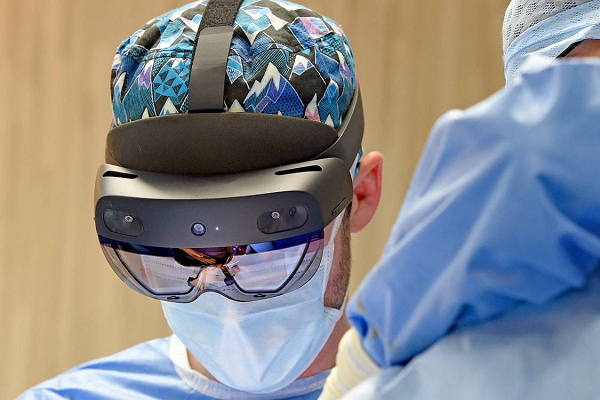Voice-Controlled Augmented Reality Headset Assists Successful Surgery
 A voice-enabled augmented reality headset aided a successful shoulder surgery at Scripps Clinic in California, a first in the region. The three-dimensional holographic view of the surgical plan projected on the patient and adjusted by voice commands improves the surgeon’s precision and the result of the surgery and could become a common element in all kinds of medical procedures in the near future.
A voice-enabled augmented reality headset aided a successful shoulder surgery at Scripps Clinic in California, a first in the region. The three-dimensional holographic view of the surgical plan projected on the patient and adjusted by voice commands improves the surgeon’s precision and the result of the surgery and could become a common element in all kinds of medical procedures in the near future.
Augmented Surgical Assistance
Wearing the headset as seen above during the procedure, the surgeon could see and control the patient’s preoperative plan, built from CT scans ahead of time. The model is superimposed over the patient without obstructing the surgeon’s view of the patient. Voice commands from the surgeon let them rotate and zoom in and out without the need to use their hands, critical when in the midst of surgery. Scripps joins nearly three dozen healthcare providers the U.S. using the headset for shoulder replacement surgery. That number is rising rapidly as its only been two years since a Minnesota surgeon employed the AR headset and control system for the first time.
“Being able to view the entire surgical plan during the operation is a big advantage for patients because it can help surgeons replicate the pre-op plan with precision,” said Dr. Brian Rebolledo, the Scripps orthopedic surgeon who performed the procedure. “Having a detailed 3D model of the patient’s surgical plan directly in our sights in real-time opens up a new window to help further enhance the procedure.”
Augmented reality in healthcare and enterprise services is on the rise as visual and voice technology improves. For instance, virtual being developer Virti uses a digital environment to train doctors to communicate better with the help of AI-powered virtual patients. The federal government has been investing in AR technology as well. Xerox scored a contract with DARPA to create an augmented reality system operated by an interactive AI teacher, while Microsoft won a $22 billion U.S. Army contract to produce enhanced versions of its Hololens 2 smart goggles. The Integrated Visual Augmentation System (IVAS) devices provide better vision and more information about the environment around the soldier, with a built-in voice assistant and tactile controls to operate the modified headset.s
Follow @voicebotai Follow @erichschwartz
Microsoft Scores $22B Army Contract for Hololens-Based AR Smart Googles








